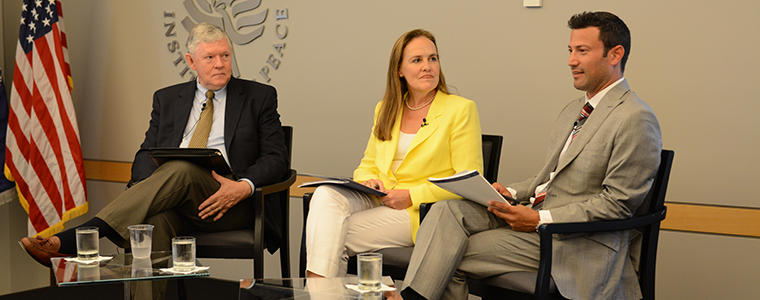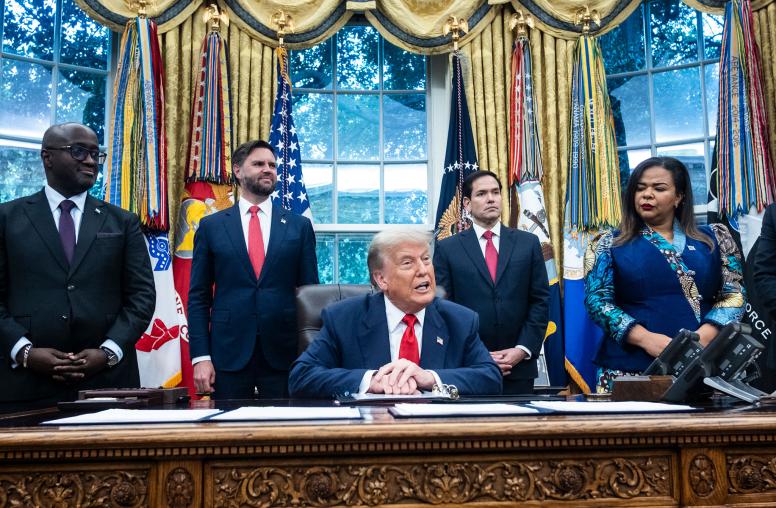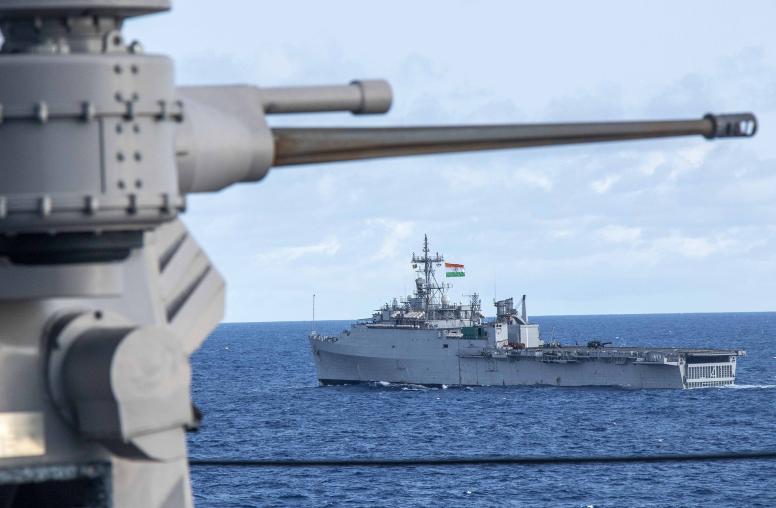U.S. Defense Budget Cuts Must Be Eased to Lower Risk, Panel Says
U.S. defense budget cuts must be eased to lessen the risk for the military’s ability to respond to crises in an era of nearly unprecedented volatility and complexity around the globe, former Under Secretary of Defense Michèle Flournoy and retired Army Lieutenant General Michael Maples said in a recent discussion at the U.S. Institute of Peace. Their urgent warnings amplified the findings of a congressionally mandated assessment of the Pentagon’s central four-year plan, the 2014 Quadrennial Defense Review (QDR).

“Our main point was to sound an alarm,” said Flournoy, one of 10 members of the National Defense Panel, which evaluated the QDR. “There’s a fundamental discussion we need to have as a nation about what kind of risk we’re willing to accept and how we’re going to pay for it.”
The panel’s report ticks off a list of dangers: “A troubling pattern of territorial assertiveness and regional intimidation on China’s part, the recent aggression of Russia in Ukraine, nuclear proliferation on the part of North Korea and Iran, a serious insurgency in Iraq that both reflects and fuels the broader sectarian conflicts in the region, the civil war in Syria, and civil strife in the larger Middle East and throughout Africa.”
The threats underscore the U.S. military’s role, perhaps more than ever, as “an indispensable instrument of national power,” Flournoy told the Sept. 4 audience. The military underpins economic prosperity by keeping trade routes open, bolsters diplomatic influence by the threat of force and supports critical alliances with defense assurances, she and Maples said.
While USIP wasn’t involved in developing the content of the report, it provided staff support and a forum for the discussions. The panel’s co-chairmen were former Defense Secretary Bill Perry and retired Army General John Abizaid, who headed the U.S. military’s combatant command for the Middle East, Southwest Asia and the Horn of Africa, known as CENTCOM. The members, who deliberated on the review over the course of a year, consisted of a mix of former government officials and ex-military leaders nominated by members of Congress.
A military for multiple theaters
While USIP’s role is “to identify and employ non-violent means to prevent, mitigate and resolve violent conflict around the world – this is an approach that is both effective and cost-effective – there’s also a role for the threat and use of force,” USIP Acting President Kristin Lord told the Sept. 4 audience. “For that, I believe that the United States needs not only a strong military but also a military that is appropriately sized and shaped to the challenges of both today and tomorrow.”
Yet, severe defense budget cuts laid out in the 2011 Budget Control Act , combined with future across-the-board reductions mandated in the law’s “sequestration” provisions, raise the degree of risk that will accumulate “in the near term” to “an unacceptable level,” Flournoy said.
“We need a military that, even if we’re engaged in one area, we can be deterring, shaping, influencing in multiple theaters at the same time and, if necessary, thwarting aggression” in the event an adversary tries to take advantage of the situation when U.S. attention is focused elsewhere, said Flournoy, who serves as chief executive officer of the Center for a New American Security, a Washington-based policy research organization that she co-founded.
The QDR was completed in early 2014, before the current tumult in Iraq and Ukraine and before the more worrying escalation of tensions in the Pacific. Its strategic construct is geared toward two concurrent military actions – defeating a regional adversary in a large-scale campaign in one theater while thwarting the objectives of an aggressor in another. The capabilities called for by the QDR to support even this construct “clearly exceed the budget resources made available to the Department,” according to the National Defense Panel’s report.
“The world is probably more dangerous than we were accounting for” in the QDR, Maples said at the USIP event. “We have to be engaged and have capability that can address threats in multiple theaters simultaneously.”
The severity of the threat from the militant group Islamic State of Iraq and the Levant (ISIL, or ISIS for an alternative name) illustrates the point. President Barack Obama, who embraced the exit of U.S. troops from Iraq 3 ½ years ago, addressed the American people last night to make the case that the national security of the United States requires military action to “degrade and ultimately destroy” ISIL. The militants have committed widespread atrocities across the swaths of Syria and Iraq that it now controls, including the recent beheadings of two American journalists.
Doing what it takes
The president in early August authorized U.S. air strikes in Iraq to rescue religious minorities trapped on a mountain surrounded by ISIL forces and to prevent the militants from getting closer to the city of Erbil, a base for American diplomatic and military personnel. Last night, Obama laid out a strategy to combat ISIL that combines military air strikes and support for allies and partners in the fight.
“Our own safety – our own security – depends upon our willingness to do what it takes to defend this nation and uphold the values that we stand for,” Obama said in his address. Yet defense budget cuts already are compromising the military’s ability to remain prepared and ready to deploy at a moment’s notice, the National Defense Panel concluded. Too many army units aren’t ready for action, military pilots’ training flights have been reduced and Navy ships are being held back to save money.
The 2011 budget legislation aimed to cut the federal deficit but leaned too heavily on reducing defense spending to do so, the panel said. And while the Defense Department could make significant cuts judiciously, Congress has limited its authority so much that it can’t take otherwise reasonable measure such as eliminating 20 percent excess infrastructure, including bases, or restructuring the burgeoning civilian work force and the acquisitions process for efficiency, the panel said.
“There are cuts that are smart and that can be made,” Flournoy said. “But this secretary of defense has not been given the appropriate authority by Congress.”
The odds of legislation to roll back the cuts are low before the 2016 presidential elections, but the campaigns might provide opportunities to have the needed public discussion about the state of U.S. national security, what role Americans see for the country in the world and what level of risk they’re willing to take at what cost, Flournoy said.
Already, public opinion polls are showing significant public support for U.S. air strikes on ISIL in Iraq and Syria. A Washington Post-ABC News poll found that 71 percent of Americans support air strikes in Iraq that began in early August, compared with 54 percent three weeks ago. And 65 percent back potential air strikes in Syria, twice the degree of support a year ago, according to the Washington Post.
“We live in a world where we’re going to be living with multiple simultaneous crises, some of which may become conflicts,” Flournoy said. “And we’d better have a force that’s robust enough and agile enough and ready enough to deal with that.”




